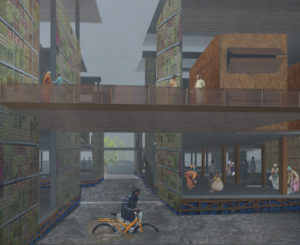Resilient Urban Edges: Adaptive and Mitigative Strategies in Chennai

This blog entry is a summary of the presentation held during the 2nd Monsoon Assemblages seminar, written by the guest presenter Vaishali Enos.
In the second Monsoon Assemblages seminar, I presented excerpts from my design-based dissertation for the Master of Science in Architecture and Environmental Design from the University of Westminster, mentored by Dr Rosa Schiano-Phan. The thesis investig
ated urban and architectural design responses to El Nino-mediated climatic disturbances, using the Chennai urban floods in December 2015 as a test case.
The effects of such disturbances, I contended, tend to be exacerbated by human intervention: in Chennai, the urbanisation-led impermeabilisation of the soil accentuated urban heat island effects, made water percolation into the ground more difficult and increased surface run-off. My investigations began by making use of sectorial and critical literature, looking at precedents and conducting interviews with residents of the Kotturpuram tenement block on the Southern bank of the River Adyar in Chennai to identify key issues. The next step was to quantify the impact of existing morphology, typology and lifestyle on comfort conditions using software as an analytical tool – Envimet, Ladybug for Rhino and Autodesk CFD for outdoor analysis and Thermal Analysis Simulation (TAS) for indoor analysis. The conclusions informed different hypotheses that were tested in my design proposal, which were merged with informal recycling practices of the tenements along the River. The dissertation deployed and discussed strategies employing both recycled and locally available materials. For instance, I demonstrated how lantana and bamboo, coconut fibre, recycled chicken mesh, junkyard metal, PET bottles, water canals and vegetation could be used to build permeable surfaces (water-air-ground interfaces) and be embedded into existing architectural objects (by retrofitting), or utilised to build new experimental floating structures complementing the existing settlement. By employing strategies tested through simulations (to measure solar access, wind movement and effect on materiality on temperatures), I sought to achieve outcomes which could guarantee both climatic comfort and safety in case of extreme climatic events, making the resettlement colony more resilient.
The architectural design, using elementary concepts introduced new horizontal lines of movement and spaces for the rich mix of uses to provide additional income to the community. The existing residential blocks are reshaped by lifting the ground (to mitigate the floods), adding floors above (to increase density) and introducing shaded spaces on the roof (to restrict solar access and allow wind). Simultaneously, it introduced a system of transitionary areas, shaded streets, screens and buffer zones to bring the temperature of the units within a range of comfort for at least 85% of the year, while enhancing the streetscape of the tenement settlement. The dissertation showed how the proposed devices bring air temperature – which can reach 42°C in extreme weather conditions – within a range guaranteeing the comfort of the occupants in the indoor and outdoor spaces; while also contributing to flood mitigation.
The urban design strategies highlighted the possibilities of rethinking how Government-led housing schemes in Chennai are conceived whilst attempting to preserve the rich social mix of the inhabitants. For this reason, the spatial needs of the local tenement community, along with those of the socio-economic networks supporting their livelihoods, were a primary focus. Inspired by an intention to alleviate social and economic polarisation currently characterising the Adyar riverfront in central Chennai, the dissertation also speculated upon a living and working environment for 2050 which could contribute to the permeability of the city’s fabric and adaptively respond to daily, seasonal and extreme events.
